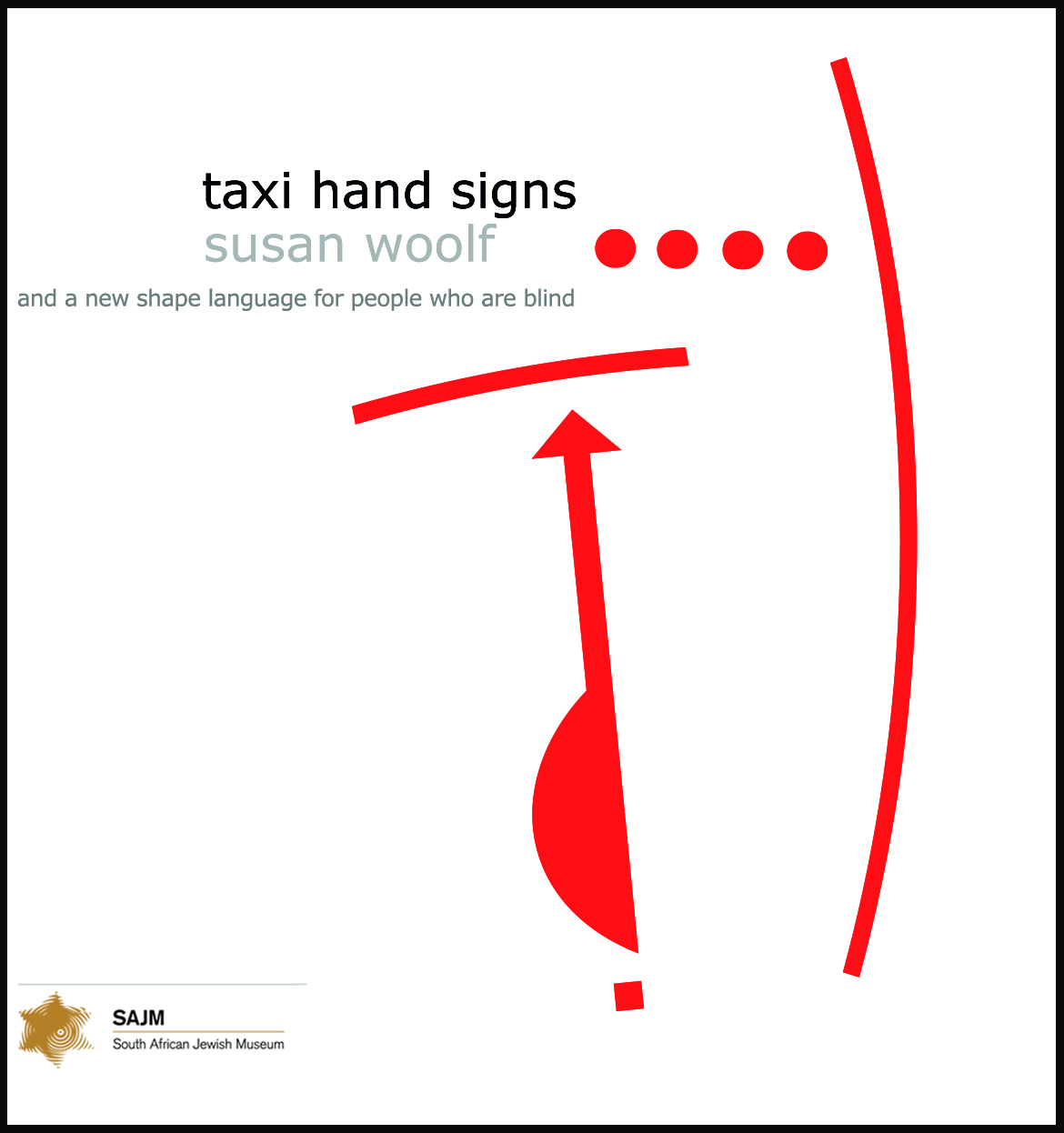

About the Book:
This limited edition catalogue, created especially for Susan Woolf's exhibition at the South African Jewish Museum in July 2016, shows Woolf's taxi hand sign and taxi hand sign for the blind art work.
Introduction: Susan Woolf’s Taxi Hand Signs
at the SAJM
Some time ago, the South African Jewish Museum (SAJM) was contacted by the local society for people who are blind, who wanted to bring a group of their members to ‘see’ the museum. This presented us with a unique challenge: how we could make the museum accessible to visitors who are blind? The SAJM’s mission is to share the story and culture of the South African Jewish community to as broad an audience as possible. How are we able to achieve this goal for a group of people who are unable to engage with the museum exhibits in the manner for which they have been designed?
In the end our solution was to host a ‘Shabbat Dinner’ for our blind visitors. Held in the museum one weekday afternoon, these visitors were able to engage with Jewish culture via their other senses. They tasted traditional Jewish cuisine, listened to the traditional Shabbat prayers, and importantly, they were able to tactilely explore various religious items used in Judaic ritual through touch.
As I was watching this event I realised that one of the major aspects of our museum—our evolving series of temporary art exhibitions—remained inaccessible to people who could not see. That is, until now.
Susan Woolf’s significant series, Taxi Hand Signs, offers all visitors the ability to engage with her artwork. Woolf has crafted a truly unique experience. Not only is her work visually stunning, it confounds every expectation. The exhibition, with an art and anthropological focus on taxi hand signs, opens our eyes to the beauty inherent in an everyday solution to a practical problem. A silent gestural system that evolved and is used daily by millions of Gauteng’s mini bus taxi commuters to signal their destination. She takes it even further by developing a graphic, tactile language of 14 simple shapes that combine to describe all of the taxi hand signs. Published in book form in 2009, the taxi gestures and their intended destinations are made accessible to people who are blind.
Woolf has done something remarkable. She’s created a multi-sensory exhibition both for people who are blind and for the sighted. People who are blind can interact with many of the exhibits, while people who have vision are asked to ‘see’ her work using only their sense of touch. In doing so, she adds richness to both worlds. The former have an exhibition they can ‘see’; and the invitation to the latter to briefly experience how people who are blind are forced to interact with a sighted world, one that is increasingly making use of the visual medium to communicate, creates a greater understanding—and an interesting power inversion, when they need to rely on a guide who cannot see. The blind shape language and taxi signification has been the catalyst for her more recent abstract artworks, which include a coded language which challenges sighted people.
The South African Jewish Museum appreciates the opportunity to show this unique art exhibition.
Statistics
Project Type:
Cover Artwork:
Author:
Illustrations:
Graphic Design:
Editor:
Book Size:
Page Count:
Binding:
Colour:
Cover:
Copyright:
Publication Year:
Edition:
Extras:
ISBN:
Publisher:
Printer:
Published
Susan Woolf
Susan Woolf
Susan Woolf
ada enup
Alicia Thomas-Woolf
210mm x 210mm
52
PVR
Colour cover, colour throughout
Soft cover
Susan Woolf
2016
1st
A very limited number of editions include original artwork
978-0-9922421-2-1
ada enup
Kadimah Printers
About the Author:
Symbolism, meaning and communication are intrinsic to Woolf’s artwork, which is generally historically or socially based.
Past artworks include Woolf’s installation Healing and 30 Art Books were exhibited in Museum Africa 1997 – 1998. A five story high aluminium kinetic Mobile City for Absa Bank was a collaboration with two architects, Levin and Cawood in 1999.
Woolf is documenting Taxi hand signs in South Africa for sighted and blind people. She published an A6 Taxi Hand Book with ada enup. It was the subject matter for an exhibition in 2010 and towards her doctoral thesis in Anthropology and Art at Wits University.
Her work on view on the Mandela @ 90 exhibition (Constitutional Court 2008) related to her solo exhibition Towards Mandela, which was held at the King Plow Center in Atlanta in 1997. This was organised through Fulton County Arts Council, Leadership Atlanta and 100 Black Men. Woolf was the Project manager of South African Art to Atlanta, Common and Uncommon Ground for the 1996 Cultural Olympiad.
Also on show at the Mandela @ 90 exhibition was a carved wooden maquette entitled Witness: Shadow of Ubuntu is a composite of eleven outdoor sculptures which, when completed, will span more than thirty meters across with a general height of 3meters. The Witnesses cast shadows which collectively read “UBUNTU” throughout the year, every day, at a specific time. Madiba’s outreach encompassing all the peoples of South Africa is a profound and living example of the true meaning of Ubuntu.
Woolf was honoured by the Ampersand Foundation and received a Fellowship to study in New York. She has had numerous other exhibitions in galleries and museums in South Africa and abroad and has artwork in major corporate and private collections.
In 2012 Woolf exhibited work on Taxi Hand Signs at the MOMA in New York in the exhibition Talk to Me.
She received her PhD in Anthropology and Art, which documented and expanded on the hitherto unexplored subject of South African Taxi Hand Signs, in 2014. With her doctorate, Woolf has added an entirely new body of knowledge to the world.
In July 2016 Woolf exhibited in the South African Jewish Museum in Cape Town, South Africa and in November was invited by the Smithsonian in Washington DC, USA to showcase her taxi stamp art and related art.